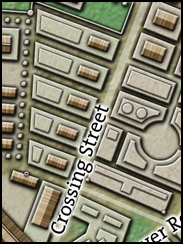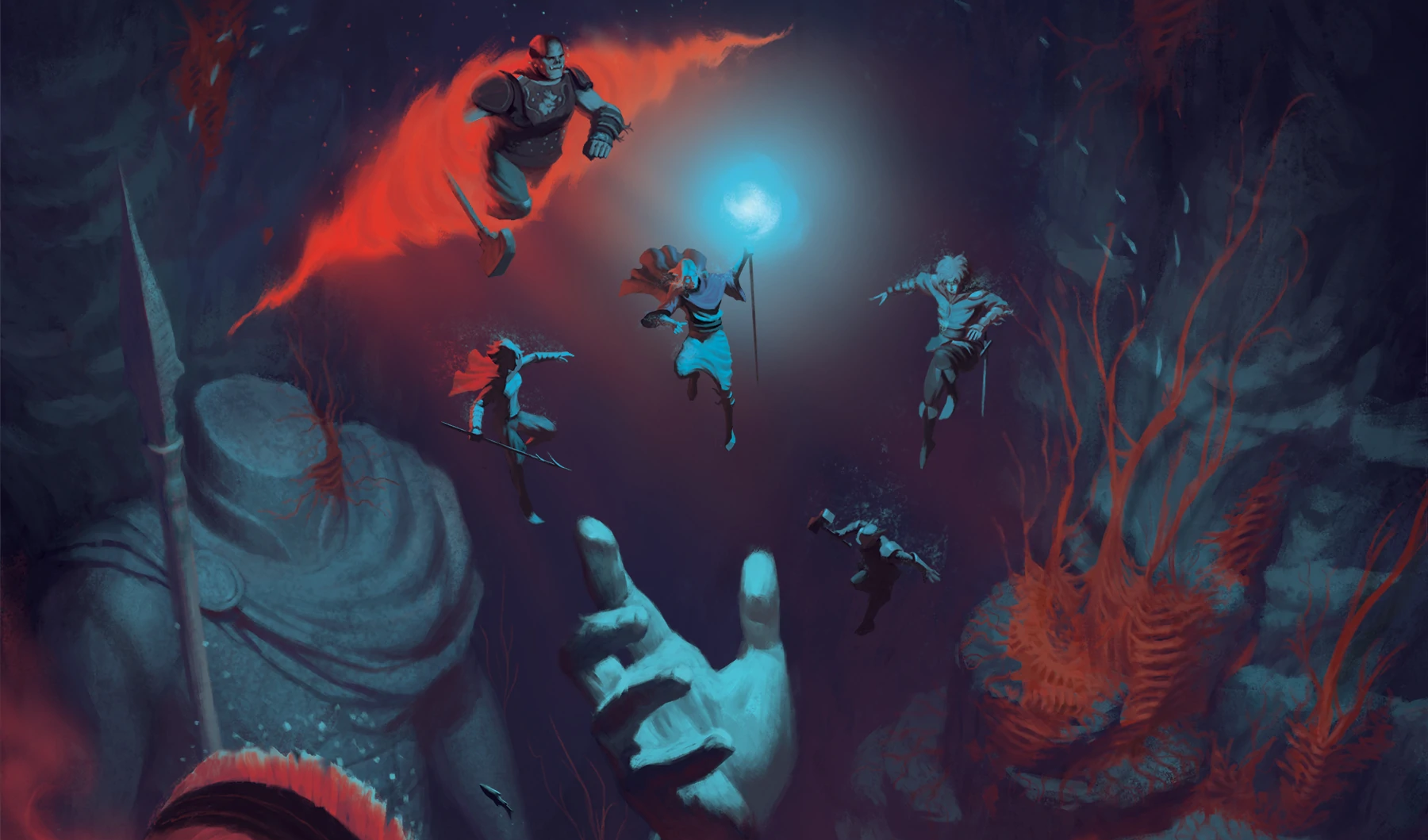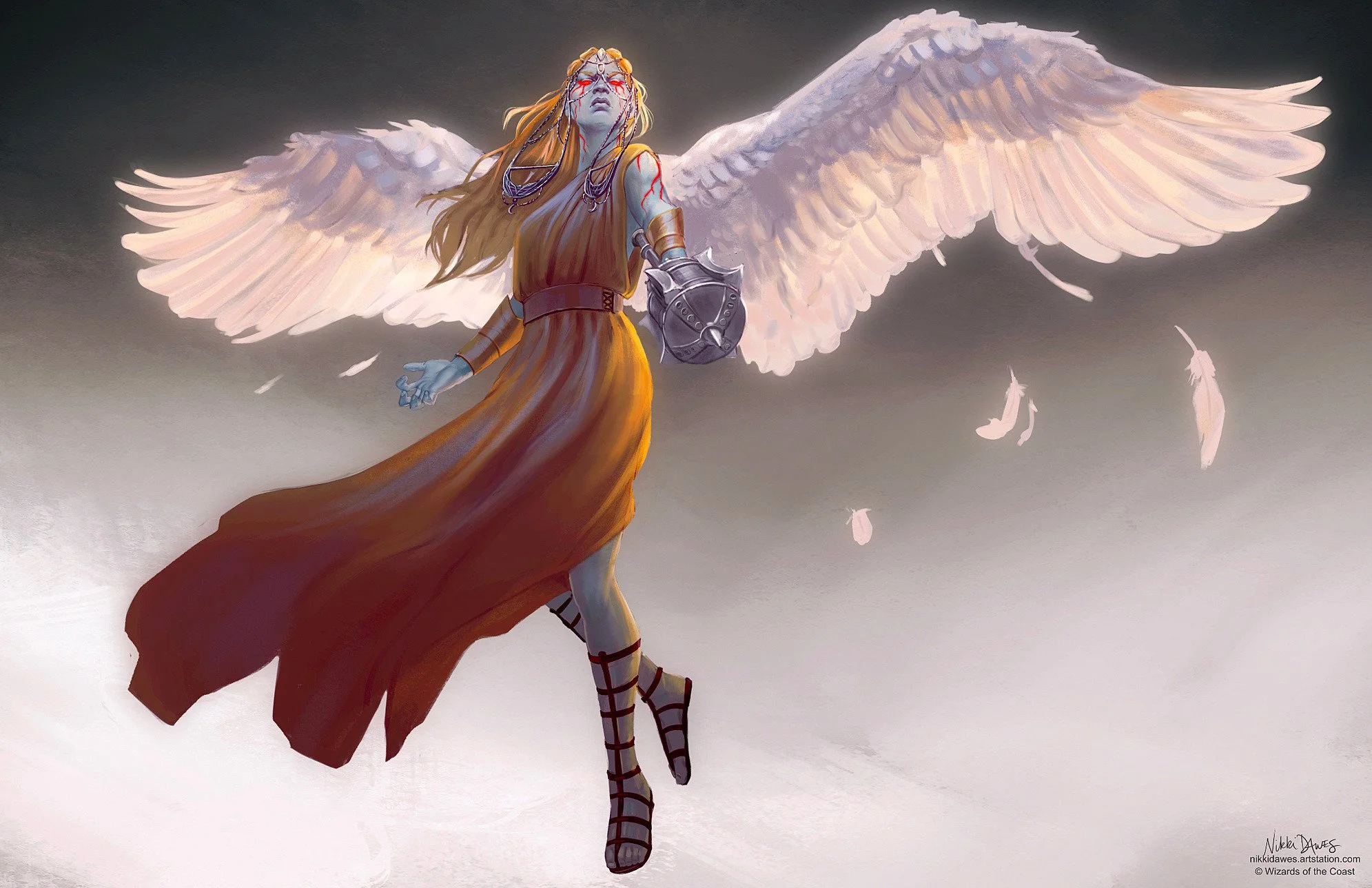
SESSION 27A: THE MIDNIGHT MEETING
September 7th, 2008
The 14th Day of Kadal in the 790th Year of the Seyrunian Dynasty
Tee put her disguise back on and hit the streets, trying to find another contact for the Brotherhood. She wasn’t having much luck, however, until she stopped looking for the Brotherhood and started looking for people who knew Jamill. After that, it wasn’t long before she was pointed in the direction of a small pub at the north end of Tavern Row where a blond woman with sparkling green eyes and a small scar above her lip was nursing a beer.
Tee gave her name as “Laurea”. The woman introduced herself as Arveth and, like Jamill, she was clearly wary of Tee’s questions regarding the Brotherhood. But once Tee actually dropped Jamill’s name, her suspicions seemed to melt away.
It turned out that Arveth had actually been waiting for Jamill to show up so that they could “talk about tonight” (a revelation which made Tee more than a little nervous). Arveth slipped Tee another of the rings with a broken square and said, “Wear this ring and come back to Tavern Row tonight at midnight.”
Tee thanked her and headed back to the Ghostly Minstrel (taking a deliberately circuitous route to throw off anyone following her and stripping off her disguise before entering the inn itself). She rejoined the others and quickly briefed them in on what she had accomplished.
There was still the problem of Iltumar. They assumed that he was probably planning to go to the meeting that night, too, and they had no idea what might be waiting for him (or Tee) there.
“Is there any way we can stop him?” Tee asked.
“Can’t we just tell him not to go?” Dominic said.
Tor rubbed his chin. “Considering the way he reacted when I tried to talk to him about it in even general terms… I don’t think it would work.”
They talked round (and round) the subject for several minutes, but eventually concluded that they couldn’t approach Iltumar directly about what was happening. Instead, they decided to distract him – keeping him busy with something else so that he wouldn’t have time to attend the meeting.
Tee crossed the hall and touched base with Ranthir (who had returned to his studies). Ranthir affably agreed with their conclusion, and was very open to the idea of letting Iltumar study with him as a way of pulling him out of the meeting.
Unfortunately, the plan didn’t work: Tor waited several hours before heading over to the Bull and Bear around ten o’clock, only to discover that Iltumar had left at nine o’clock. Iltumar had told Hirus that he was going over to the Ghostly Minstrel… but he wasn’t there.
Tor went back and told the others. “He’s gone.”
THE MIDNIGHT MEETING
(09/15/790)
Tee had already resolved to go to the meeting: If Arveth was going to be there, she would be expecting Tee (as “Laurea”) to be attending. There was no sense throwing away all the work they’d done to make contact with the Brotherhood, and Tee might be able to learn something valuable from the meeting itself.
The possibility of someone going with Tee (using the ring they had found in Pythoness House) was briefly raised, but they eventually decided not to push their luck. Elestra was concerned for Tee’s safety and made it clear that, if Tee hadn’t returned within a couple of hours, the rest of them would come looking for her. It wasn’t entirely clear to Tee what they could do (since none of them even knew where the meeting was going to be held, exactly), but there wasn’t much time to argue about it: With midnight rapidly approaching, Tee slipped back into her disguse, went out the rear door of the Minstrel, and circled around to the south to make it appear that she was approaching Tavern Row from the opposite direction.
As she arrived, Tee spotted Arveth at the far end of the Row. But she was approached by a different woman with mousy-brown hair. The woman gave Tee an innocuous greeting, but with a subtle tilt of her head she indicated a nearby rooftop. Tee surreptitiously glanced in that direction and spotted a shabbily dressed girl. With Tee following on the street below, the little girl ran down the roofs and came to a stop next to an alley near the middle of the block.
One of the buildings flanking this alley was a small, seedy-looking pub named the Rat’s Nest. Tee could see that the backdoor of the pub opened into the alley. The door was open and a woman dressed like a serving wench was standing in it. When she saw Tee round the corner, she waved her over. As Tee drew near, she opened another door that led into a small, open area. Several large, wooden crates had been stacked up in this space, allowing Tee to climb up onto the rooftop garden of the building directly behind the Rat’s Nest (which fronted onto Runshallot Street).
The only other exit from the rooftop garden was a door. With a shrug of her shoulders, Tee swung it open. The room beyond appeared to be nothing more than a sparsely-decorated living quarters. Three thugs were crowded around a small table, playing cards. As Tee entered, they looked up. One of them pointed towards a bench that had been shoved up against the wall near a flight of stairs leading down to the first floor. Spread out across the top of the bench were a dozen white masks with crude eyeholes cut in them.
“Put on a mask, then go downstairs.”
Tee nodded. She was actually quite grateful for the mask, since it would save her the difficulty of figuring out what to do if Iltumar recognized her. She grabbed a mask, tugged it down over her head, and then headed down the stairs.
The stairs bottomed out into what appeared to be a cobbler’s shop. There was a large table near the fireplace, with a half-dozen cultists in identical masks sitting around it. As Tee came down the stairs, they turned and stared at her. The effect was deeply disconcerting.
At the bottom of the stairs, another cultist waited – this one unmasked. “Take a seat. Keep your mask on. And remember, no names.”
Tee nodded her understanding and headed over to the table. Her eyes instinctively found the exits: The stairs she had come down and two doors – one that might lead outside and another directly opposite it.
A few minutes later, there was the sound of movement coming from above and then another masked cultist came down the stairs. Tee recognized his stride and his body language. It was Iltumar.
Oh, Iltumar… Tee thought. What are you doing?
With Iltumar’s arrival, the greeter at the bottom of the stairs was apparently satisfied. He crossed to the inner door and knocked.
A moment later, the door swung open and a large centaur entered the room, stooping under the human-sized lintel.
Oh shit, Tee thought. She didn’t recognize him, but it was possible that he knew her. There weren’t that many centaurs in the city, and most of them had some sort of connection to the Narred enclave.
“My name is Dilar,” the centaur said. “And I am honored to see so many who are ready to take the first, glorious steps in championing the cause of freedom. You have come to this meeting from many different places and for many different reasons. But you share a common dream – a dream which the Republicans have begun, but which they were not daring enough to realize!”
Tee cringed at the thought of the Republicans – who had tried to kill the Commissar – not being daring enough, but there was a palpable sense of excitement from the others around the table and she was careful to match it.
“We have a real chance to make a difference!” Dilar said. “To change the course of history! By choosing to be here, you have chosen to be heroes. You have chosen greatness.”
Tee saw Iltumar straighten up at the mention of the word “hero”.
“By coming here, you have already joined this Brotherhood,” Dilar continued. “Over the next few weeks you will be contacted. For many of you there will be training. You will be asked to do things. Many of these things will seem simple or even unimportant, but you should never doubt that in even the smallest service you are aiding the Brotherhood and all that we are attempting to accomplish. Over time, your responsibilities will increase.
“The truth is that, even now, we are in desperate need of your help. And so I am asking for all those who can immediately commit themselves fully to our cause to volunteer for our newest project.”
Iltumar’s hand shot up. Several others, including Tee’s (against her better judgment), followed.
“Excellent.” Dilar smiled. “Now, for one final point of business. We have many allies in our struggle. Among them are the brothers of the Ebon Hand. They have a public temple, but as long as we must operate in secret it is important that none of you should go there. However, if any of the Ebon Hand should contact you, you should treat their words as if they came from the mouths of the Brotherhood itself.”
With the meeting concluded, the greeter instructed those who had not volunteered to return upstairs and then leave the way they had come. The others, one at a time, were let out through the front door.
THE PROJECT SITE
Once outside, Tee was met by Arveth. With few words exchanged between them, Arveth led Tee to an apartment complex on Crossing Street in Oldtown.
Arveth identified one of the buildings as the “project site” and explained that security had become very important. She led Tee to a position in an alley across the street from the building from  which she could covertly observe the building’s entrance, then she taught her several hand-signs.
which she could covertly observe the building’s entrance, then she taught her several hand-signs.
“Members of the Brotherhood will identify themselves using these signs,” Arveth said. “You’ll stand watch between the hours of midnight and six o’clock every day. If anyone attempts to enter or leave the complex without properly identifying themselves, you should raise the alarm. Do you understand?”
Tee nodded. She was certain that the “Brotherhood” was planning to kill the Commissar (what other work of the Republicans could the cultists want to carry out?), and she desperately wanted to know what could be hidden inside the apartment complex which could further those designs… but Arveth either didn’t know or didn’t think that Tee should know. Pushing the issue might make her suspicious, and Tee had the feeling that she was in deep enough at this point that she wouldn’t be allowed to simply back out of the deal.
Arveth arranged to pass messages to Tee through the Delver’s Guild, and told her that she could contact Arveth in the tavern where they had first met during the evening hours.
With these arrangements made, Arveth left Tee to her first shift.
However, this left Tee with something of a dilemma: She knew that her friends were waiting for her at the Ghostly Minstrel, and the hour was fast approaching when they would abandon restraint and come looking for her on Tavern Row. Their efforts might come to no effect at all, but they could just as easily bumble their way into ruining all of her work at infiltrating the Brotherhood.
While keeping a faithful watch on the apartment complex, Tee planned carefully. After about half an hour, she started looking around nervously. This escalated until she was actively miming the need to relieve herself.
Hoping that her act had convinced anyone watching her, she retreated down the alley. Emerging onto Tower Road, she was able to flag down a carriage and ride it to the White House – a nearby gambling establishment that she had visited a few weeks earlier. As she had hoped, there were several messengers waiting to service the large, late-night crowds there. She quickly wrote out a terse message assuring the others that she was safe and that she should not go to Tavern Row, dispatched the messenger, and then slinked back to her post on Crossing Street.
Tee had no way of knowing what she might have missed during her absence, but the rest of the night passed quietly. Just as her shift was ending, however, she saw two men in black robes leave the apartment building. They gave the proper signs and headed south down the street.
Tee briefly considered following them, but then discarded the idea. A few minutes later she concluded that no one was coming to specifically relieve her (she guessed that the other shifts must be watching the building from different locations), and she slipped away quietly.
NEXT:
Running the Campaign: Missing Clues – Campaign Journal: Session 27B
In the Shadow of the Spire: Index















